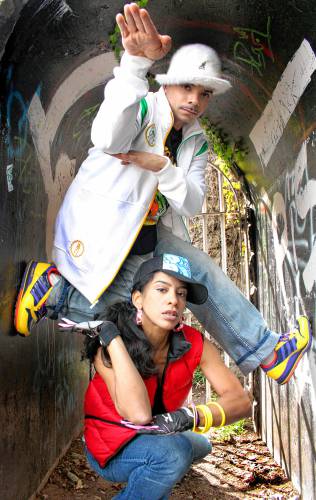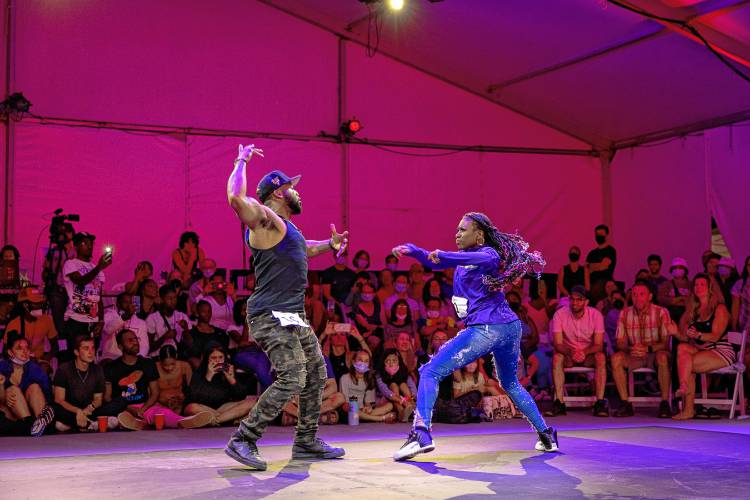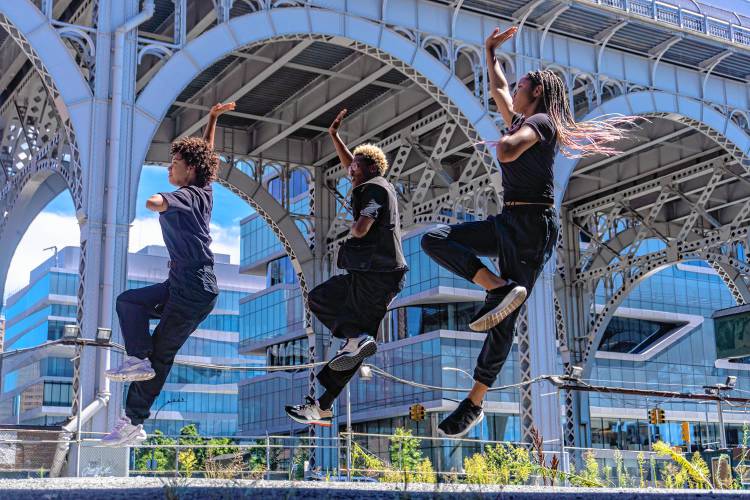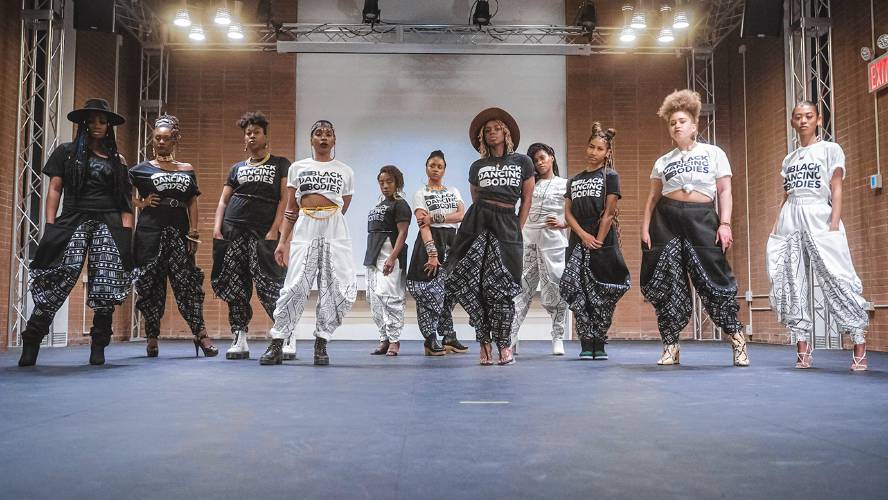By MELISSA KAREN SANCES
For the Advocate
When it was time for the hip hop tribute at this year’s Grammys, Black Thought took center stage to introduce his girl:
“Fifty years ago, a street princess was born to be an icon. The art form took the entire world by storm. How’d she do it? Her influence, constantly raising the stakes each generation. Domination by whichever means it takes to go from a spark into a flame that became public domain…”
But the artists there for Lady Hip Hop were mostly men. No disrespect: I enjoyed them all, especially Busta Rhymes and his epic speed-medley. But why weren’t there more women on stage?
There will be. This summer, the annual international dance festival at Jacob’s Pillow in Becket will feature a week-long “Hip Hop Across the Pillow.” From August 2 to 6, legends like Rokafella, Ladies of Hip Hop and Keep Rising to the Top will pop, lock, spin, freeze and battle across two stages in the Berkshires. Then visiting scholar Imani Kai Johnson will put the genre’s 50 years in perspective.
In honor of this historic week, we spoke with some of hip hop’s contemporary queens. Here’s a medley of their history.
1979: Ana “Rokafella” Garcia
The girl with the big hair and the gap in her teeth had just become cool. She would credit her older brother, who introduced her to a brand-new song called “Rapper’s Delight” by the Sugarhill Gang. But he didn’t know she’d memorize its 15 minutes of lyrics and start reciting them at school:
“I said-a hip, hop, the hippie to the hippie
To the hip hip hop and you don’t stop…”
Now the 8-year-old Latina from New York City was in the flow. But she had no plans to be a rapper. As a teenager, Ana Garcia would fall in love with breaking, or freestyle dancing during a song’s break, when everything drops away but the beat and the groove. She would become one of the first break girls, better known as B-girls, to take the genre by storm. She would need a new name, something iconic, something as momentous as Rockefeller Center, where she would learn – to her mother’s horror – how to spin on her head.
How could that little girl have known? Hip hop would be her passport to uncharted territory: a world where women could be baller.

Rokafella will perform a new duet with her husband Kwikstep, with whom she’s been partnered for 28 years. “All things are possible in hip hop and you can find love,” she says. PHOTO BY B FRESH PHOTOGRAPHY
1989: Violeta Galagarza / Keep Rising to the Top
She would not choose between mother or dancer.
When she got pregnant, Violeta Galagarza would have to give up her scholarship to the Alvin Ailey Dance School. But she would have her boy. And she would open her own space where movement was transcendent.
“I was passionate and hungry,” she says, “and because I’m from Spanish Harlem, because I’m a Latina, all my life it was no, no, no.”
The young women and men who came to learn from her had been silenced by violence and loss. If they had the words, they might have told her that they feared death as much as they were resigned to it. She took them in and told them yes.
She would give them a voice and a stage. Many of her students would go on to dance back-up for artists like Missy Elliott or Beyonce.
But at 17, Galagarza had one mission: to Keep Rising to the Top, or KR3Ts, the name she gave the company she founded.
1999: Lauryn Hill
When the 23-year-old goddess made history as the first rap artist to win Album of the Year, her eyes glistened as she thanked God.
But even she found the accolade hard to believe. “This is crazy, ‘cause this is hip hop music,” Lauryn Hill said to the crowd. “You know what I mean?”
She won 5 Grammys that evening.
2009: Michele Byrd-McPhee / The Ladies of Hip Hop
Ladies of Hip Hop was founded in 2004 to empower women through dance. COURTESY LADIES OF HIP HOP
The Ladies of Hip Hop were on Facebook. Next year they’d be on Instagram. Soon what started as a group to empower women in Long Island would become an international festival.
“Street dance culture has been a marginalized community for so long,” says Ladies’ founder Michele Byrd-McPhee. “There’s still a lot to figure out, but people are now looking while we’re figuring it out.”
Inspired by her music-loving mother and her mentor Marjory Smarth, a dance battle warrior and a power of example for women in hip hop, Byrd-McPhee founded Ladies in 2004. Her son grooved in the womb and she would carry him like a backpack to rehearsals. “How do you do that? How do you not apologize for bringing your kid?” some of the girls would ask her, and she would welcome the chance to teach them that women could be boundless.

The competition was fierce but friendly at last year’s All Styles Dance Battle at Jacob’s Pillow. PHOTO BY DANICA PAULOS
2023: Dr. Imani Kai Johnson
Being a hip hop scholar isn’t a duty she takes lightly.
When she started in academia, Dr. Imani Kai Johnson was fascinated by cyphers, or dance circles where energy is exchanged among participants. In a cypher, she explains, girls who are often socialized not to take up space can dance freely while everyone else steps back. If a girl is challenged while in the center of the circle, she can use movement to take a stand, to say wordlessly: Yeah, I’m dope and you need to respect that.
At its essence, Johnson realized, hip hop gave women and men permission to take up space, on the streets or on the stage. It was a gateway to agency for people who had been marginalized to death.
So when the associate professor at the University of California was asked to co-edit The Oxford Handbook of Hip Hop Dance Studies, she understood the stakes. The landmark, academic ode to the history of the genre was published last year.
In August, Johnson will be the visiting scholar at “Hip Hop Across the Pillow.” During the celebratory week, Rokafella will perform a new duet with her husband Kwikstep, the Ladies of Hip Hop will be accompanied by d. Sabela Grimes, and Keep Rising to the Top will take the stage with The Hood Lockers. Other highlights include a performance by Rennie Harris Puremovement and an All Styles Dance Battle.
“I think that women – not I think, I know – that women have always been a fundamental component of hip hop culture,” says Ali Rosa-Salas, associate curator at Jacob’s Pillow. “We have always been here.”

A pioneer of hip hop dance theater, Rennie Harris Puremovement returns to the Pillow after 13 years. PHOTO BY DANZEL THOMPSON STOUT
Reserve your tickets for “Hip Hop Across the Pillow” at www.jacobspillow.org.
Melissa Karen Sances can be reached at melissaksances@gmail.com.



